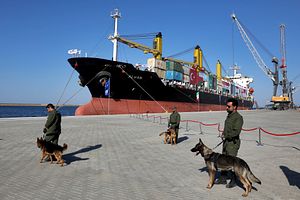India, with one of the world’s fastest growing economies, has by necessity looked to expand its trade relations and establishing access to new markets. One growing market is Central Asia. Pakistan’s Gwadar port is one possible route for India to access Central Asia’s markets, but due to its adversarial relationship with Pakistan, India has long looked to find alternative routes.
One of the alternative ways for the country to reach Central Asia is through Afghanistan. Afghanistan also seeks to diversify its trade routes to reach international markets and reduce its dependency on Pakistan, through which much of Afghan trade passes given that the country is landlocked. In 2003, India, Afghanistan and Iran, under the North-South Transport Corridor framework, signed the Chabahar port agreement, allowing all three countries to utilize the Chabahar port as a trade hub.
Chabahar port is situated in Sistan and Baluchestan Province in south Iran on the Gulf of Oman. Pakistan’s Gwadar is about 70 kilometers to the west along the coast. Afghanistan is connected to the port through its land border with Iran, and India via the sea. Thus, the port is readily accessible for all the three countries and acts to facilitate trade among them. Chabahar is considered to be a significant opportunity for India and Afghanistan to bypass Pakistan’s Gwadar seaport and its trade routes. The first phase of Chabahar port was inaugurated in December 2017. India committed to invest $500 million, according to the first phase agreement.
As a landlocked country, Afghanistan has mostly relied on Pakistan’s trade routes to export its commodities. Chabahar is the only port outside of Pakistan that connects Afghanistan to the sea. Iran has promised to allow Afghanistan to use the port with low port fees and only impose meager tariffs on Afghanistan’s goods. In 2009, India constructed a road from Chabahar to Afghanistan, valued at $136 million, it forms a part of the circle road that connects Herat and Kandahar provinces in southern Afghanistan to Kabul and then to Mazar-e-Sharif in the north, and finally, the full route connects Afghanistan to Uzbekistan. India also plans to build a 900 km railway track from Chabahar port to Bamiyan province, where an Indian consortium recently won a contract to mine the Hajigak iron ore deposit in the western part of Afghanistan.
Critically, the use of Chabahar would help wane Afghanistan of its dependency on Pakistan’s routes, which has always been challenging to Afghan traders. The port would allow Afghanistan another way to export its products to international markets, and will also create thousands of jobs. The Chabahar project could have a tremendous impact on Afghanistan’s economic growth. Since Afghanistan began pursuing connectivity projects, including Chabahar, in the region, it is estimated that the trade value between Afghanistan and Pakistan through Torkham border has declined to $500 million from $2.5 billion.
In November 2017, the first Indian shipment — 700,000 tons of wheat — bound for Afghanistan arrived in Chabahar. Afghan President, Ashraf Ghani, inaugurated the first Afghan cargo bound for the port — 570 tons of goods — in February 2019. The second shipment — 80 tons of Afghan dry fruits — was sent to India through the port in June 2019. The current exports value of Afghan exports amount to about $1 billion, with Afghan officials confident that with Chabahar, that number can increase to $2 billion in the next year. Afghanistan may be a landlocked country, but it sits at the heart of critical trade routes between Central and South Asia, granting it increased importance in boosting regional connectivity.
Despite the United States’ withdrawal from the Joint Comprehensive Action of Plan (JCPOA) in May 2018 and re-imposition of major sanctions on Iran, these have not so far included the Chabahar port because Afghanistan’s development and economic growth are at the core of the United States’ South Asia strategy.
In addition to benefiting Afghanistan, Chabahar also benefits India. China and India have long competed over economic opportunities and resources in South and Central Asia. China has already invested in a strong strategic and economic relationship with Pakistan, and both countries are striving to increase their economic and trade cooperation through the China Pakistan Economic Corridor (CPEC) and Gwadar port, which both are part of China’s Belt and Road Initiative (BRI). At the same time, India has also worked to find new strategic partners through which it can enlarge its trade activity in the region. Thus, Chabahar port is in line with India’s strategic goals. It is an important pillar of Indian foreign policy aimed at finding shorter routes for its exports and imports, countering China’s influence in the Indian Ocean region, and circumventing Pakistan’s Gwadar port.
India believes that Chabahar, under its influence, will become one of the largest trade hubs in the future. The port will also connect India to Central Asian countries that are also major energy producers in the region. It is estimated that the port will help India to halve the time and cost of doing business with Central Asian countries. The port’s success also potentially takes business from Pakistan’s Gwadar, a pleasant prospect for India.
Khesraw Omid Farooq is a Fulbright scholar and holds a master’s degree from the University of Kentucky. Previously he worked as a foreign relations adviser to the Afghan minister of higher education and as a senior presenter for political shows on TOLOnews Tv. He tweets @OmidFarooq.

































